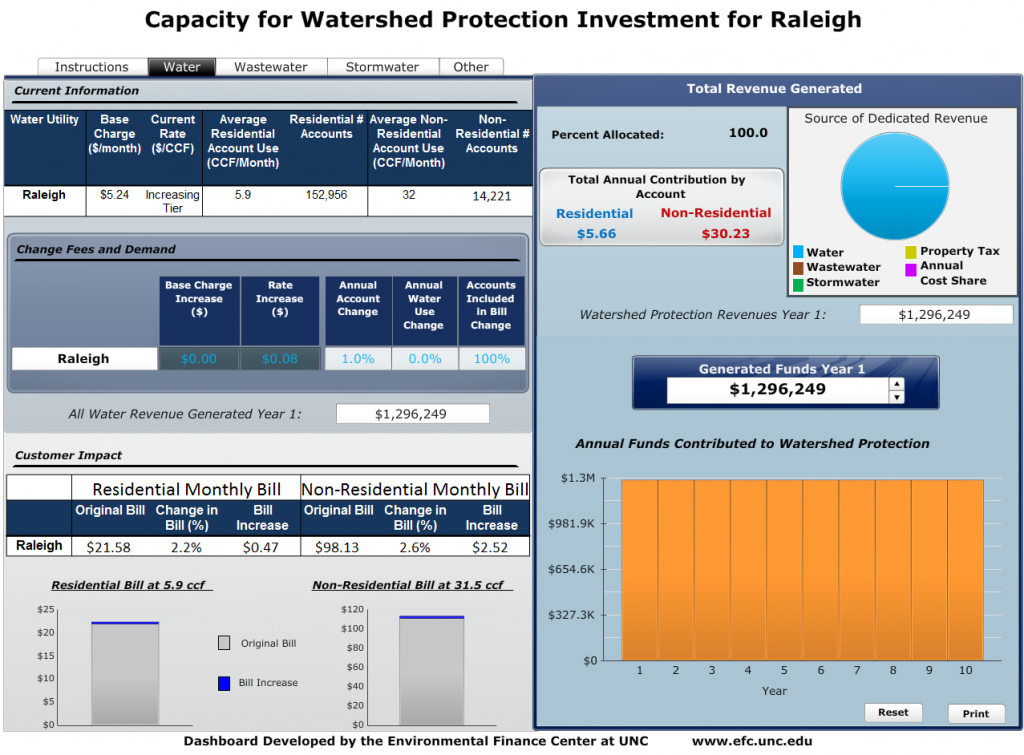 The challenges associated with designing and implementing water conservation finance strategies are multifaceted. First, stakeholders must agree on the initial environmental problem and forge an agreement of action. Second, participants must identify who should pay for protection efforts and where the money will come from. Third, local governments and utility mangers must be able to anticipate how different funding strategies will impact residents and non-residents. And fourth, officials must be able to communicate all of this information to stakeholders clearly, effectively, and transparently.
The challenges associated with designing and implementing water conservation finance strategies are multifaceted. First, stakeholders must agree on the initial environmental problem and forge an agreement of action. Second, participants must identify who should pay for protection efforts and where the money will come from. Third, local governments and utility mangers must be able to anticipate how different funding strategies will impact residents and non-residents. And fourth, officials must be able to communicate all of this information to stakeholders clearly, effectively, and transparently.
Nowhere are these challenges more at play than in efforts to clean up the Upper Neuse River Basin (UNRB) located in North Carolina’s piedmont region.
The environmental problem
The UNRB is comprised of three tributaries that flow from upstream sources, including the City of Durham, through the Falls Lake Reservoir, which is the primary water source for the City of Raleigh. Due to heavy urbanization, polluted runoff, and erosion, Falls Lake and many of its tributaries remain in a perpetual state of impairment.
Paying for clean-up
Local governments and land protection organizations have joined forces to help protect land in the Upper Neuse. The partnerships led to the creation of the Upper Neuse Clean Water Initiative (UNCWI) with the goal of protecting surface water quality in the UNRB through land conservation. The City of Raleigh created a watershed protection fee to fund conservation projects which has created a stable recurring source of revenue that can be leveraged with funds from other organizations. Prior to the creation of the fee, Raleigh had provided a majority of local government funding through fixed annual appropriations. These appropriations were generally financed by a nutrient impact fee levied on new development. In total, Raleigh’s contributions channeled approximately $6 million between 2005 and 2009, serving as a reliable source of direct revenue from the city.
Modeling different financing strategies and understanding the impact on customers
In order to address these policy considerations, the EFC developed an interactive “dashboard,” a visual system that helps users model different funding scenarios and visually communicate performance metrics. The Capacity for Watershed Protection Investment Dashboard is a user-friendly and transparent tool that can help utility and city managers quickly showcase different revenue options for conservation goals and communicate the financial impacts on residential and non-residential billing. Users can select the target amount needed to fund capital or conservation costs, enter the loan term and interest rate, and quickly understand total annual contributions from residents and non-residents as well as long-term watershed revenue projections.
Communicating financial strategies effectively
Increasing customers’ water rates can be controversial and political. Given the contested nature of fees, it is hugely important for utility managers and local officials to communicate the impacts on customers in a clear and open manner. The graphic below, adapted from the Capacity for Watershed Protection Investment Tool, displays a $0.08 per 1,000 gallons sold fee increase in monthly water bills and total generated revenue in Raleigh. The bar graph on the left displays the percent increase in monthly bills, ranging from a 2.2 percent increase ($0.47) for residents to a 2.6 percent increase ($2.52) for non-residents. The table on the right features total revenue generated based on the $0.08 fee increase as well as annual funds for watershed protection over a ten-year period.
One of the most useful aspects of the dashboard is its ability to showcase how a small increase in base charges can generate significant revenue for watershed conservation. The ability to communicate this information to customers can lead to considerable advances in watershed conservation efforts. For example, in 2011 Raleigh and Durham’s utility staffs used the dashboard to demonstrate the revenue-generating capacity from a small increase in monthly water rates. That year, Raleigh passed a 1-cent per 100 gallon fee on all municipal water users, which costs the average household about 40-cents per month and generates around $1.5 million per year for land acquisition and other water quality protection projects
Overcoming the communication challenge
The clean-up goals put forth under UNCWI highlight the need for effective, long-term financial planning. Although Raleigh, Durham, and other municipalities in the UNRB watershed are working to achieve pollution reduction goals, there is a constant push for additional watershed protection funds. Identifying effective financial strategies can be both technically and politically challenging, making clear and effective communication ever more important. The EFC’s dashboard is an innovative tool that can help managers communicate revenue-generating strategies in a way that is both visual and easy to understand.
The tool displays graphically what is hard to capture in words: nominal changes to water fees can mean significant opportunity for water conservation. Conveying that message is half the battle.
Ready to try it yourself?
The EFC created a generic Capacity For Watershed Protection Investment Dashboard in which users can input information about a specific utility’s current water, wastewater, and stormwater rates (check here for rates data for NC). The tool generates models showcasing various funding capacities to generate revenues for watershed protection. It also includes other options such as creating a “watershed fee” through property tax bills instead of the utility bill. Funds generated by these options can be used as a match for grants that require a cost-share. Alternatively, the funds can be used to amortize a loan, since the tool demonstrates to lenders how the funds will be generated for loan repayment.






0 Comments
1 Pingback